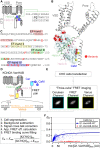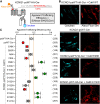Arrhythmia-associated calmodulin variants interact with KCNQ1 to confer aberrant membrane trafficking and function
- PMID: 37965565
- PMCID: PMC10642763
- DOI: 10.1093/pnasnexus/pgad335
Arrhythmia-associated calmodulin variants interact with KCNQ1 to confer aberrant membrane trafficking and function
Abstract
Missense variants in calmodulin (CaM) predispose patients to arrhythmias associated with high mortality rates ("calmodulinopathy"). As CaM regulates many key cardiac ion channels, an understanding of disease mechanism associated with CaM variant arrhythmias requires elucidating individual CaM variant effects on distinct channels. One key CaM regulatory target is the KCNQ1 (KV7.1) voltage-gated potassium channel that carries the IKs current. Yet, relatively little is known as to how CaM variants interact with KCNQ1 or affect its function. Here, we take a multipronged approach employing a live-cell fluorescence resonance energy transfer binding assay, fluorescence trafficking assay, and functional electrophysiology to characterize >10 arrhythmia-associated CaM variants for effect on KCNQ1 CaM binding, membrane trafficking, and channel function. We identify one variant (G114W) that exhibits severely weakened binding to KCNQ1 but find that most other CaM variants interact with similar binding affinity to KCNQ1 when compared with CaM wild-type over physiological Ca2+ ranges. We further identify several CaM variants that affect KCNQ1 and IKs membrane trafficking and/or baseline current activation kinetics, thereby delineating KCNQ1 dysfunction in calmodulinopathy. Lastly, we identify CaM variants with no effect on KCNQ1 function. This study provides extensive functional data that reveal how CaM variants contribute to creating a proarrhythmic substrate by causing abnormal KCNQ1 membrane trafficking and current conduction. We find that CaM variant regulation of KCNQ1 is not uniform with effects varying from benign to significant loss of function, suggesting how CaM variants predispose patients to arrhythmia via the dysregulation of multiple cardiac ion channels. Classification: Biological, Health, and Medical Sciences, Physiology.
Keywords: KCNQ1; KV7.1; arrhythmia; calmodulin; calmodulinopathy; ion channels.
© The Author(s) 2023. Published by Oxford University Press on behalf of National Academy of Sciences.
Figures






Update of
-
Arrhythmia-associated Calmodulin Variants Interact with KCNQ1 to Confer Aberrant Membrane Trafficking and Function.bioRxiv [Preprint]. 2023 Jan 29:2023.01.28.526031. doi: 10.1101/2023.01.28.526031. bioRxiv. 2023. Update in: PNAS Nexus. 2023 Oct 14;2(11):pgad335. doi: 10.1093/pnasnexus/pgad335. PMID: 36747728 Free PMC article. Updated. Preprint.
References
Grants and funding
LinkOut - more resources
Full Text Sources
Research Materials
Miscellaneous

